Revenue Recognition: Impact on Australian Financial Institutions
VerifiedAdded on 2023/06/04
|11
|2309
|116
Report
AI Summary
This report examines revenue recognition standards and their applicability to financial companies in Australia. It scrutinizes guidelines issued by FASB and IASB, addressing emerging issues and implementation challenges. The report analyzes two research articles focusing on understanding old versus new revenue recognition standards, accounting and operational challenges, and changes in accounting software. Key findings include changes in financial statement presentation, the importance of effective transition methods, and the implications for various stakeholders like accountants, regulators, and external users. The report concludes by highlighting the usefulness of these findings for improving revenue recognition practices within Australian financial companies.
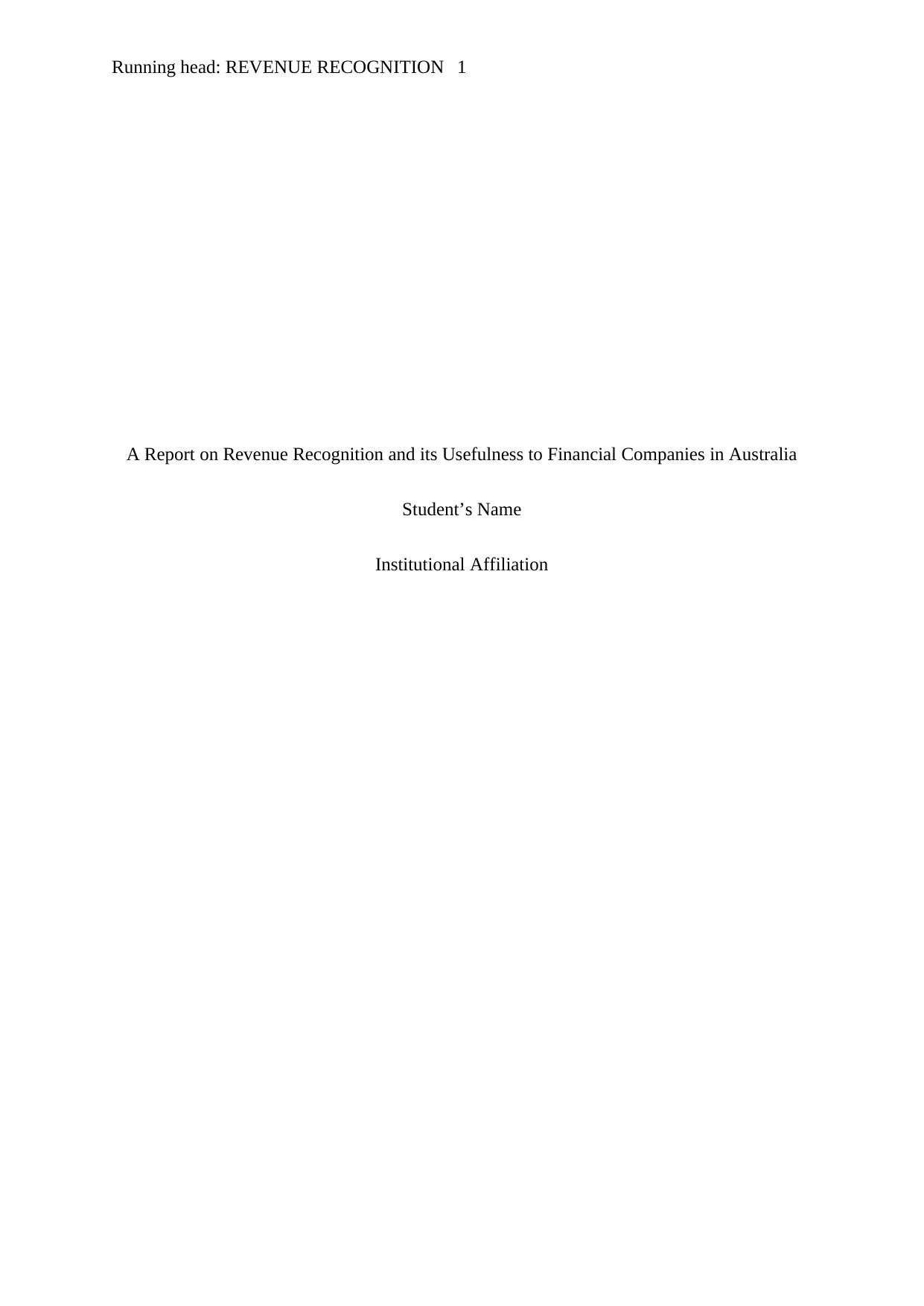
Running head: REVENUE RECOGNITION 1
A Report on Revenue Recognition and its Usefulness to Financial Companies in Australia
Student’s Name
Institutional Affiliation
A Report on Revenue Recognition and its Usefulness to Financial Companies in Australia
Student’s Name
Institutional Affiliation
Paraphrase This Document
Need a fresh take? Get an instant paraphrase of this document with our AI Paraphraser
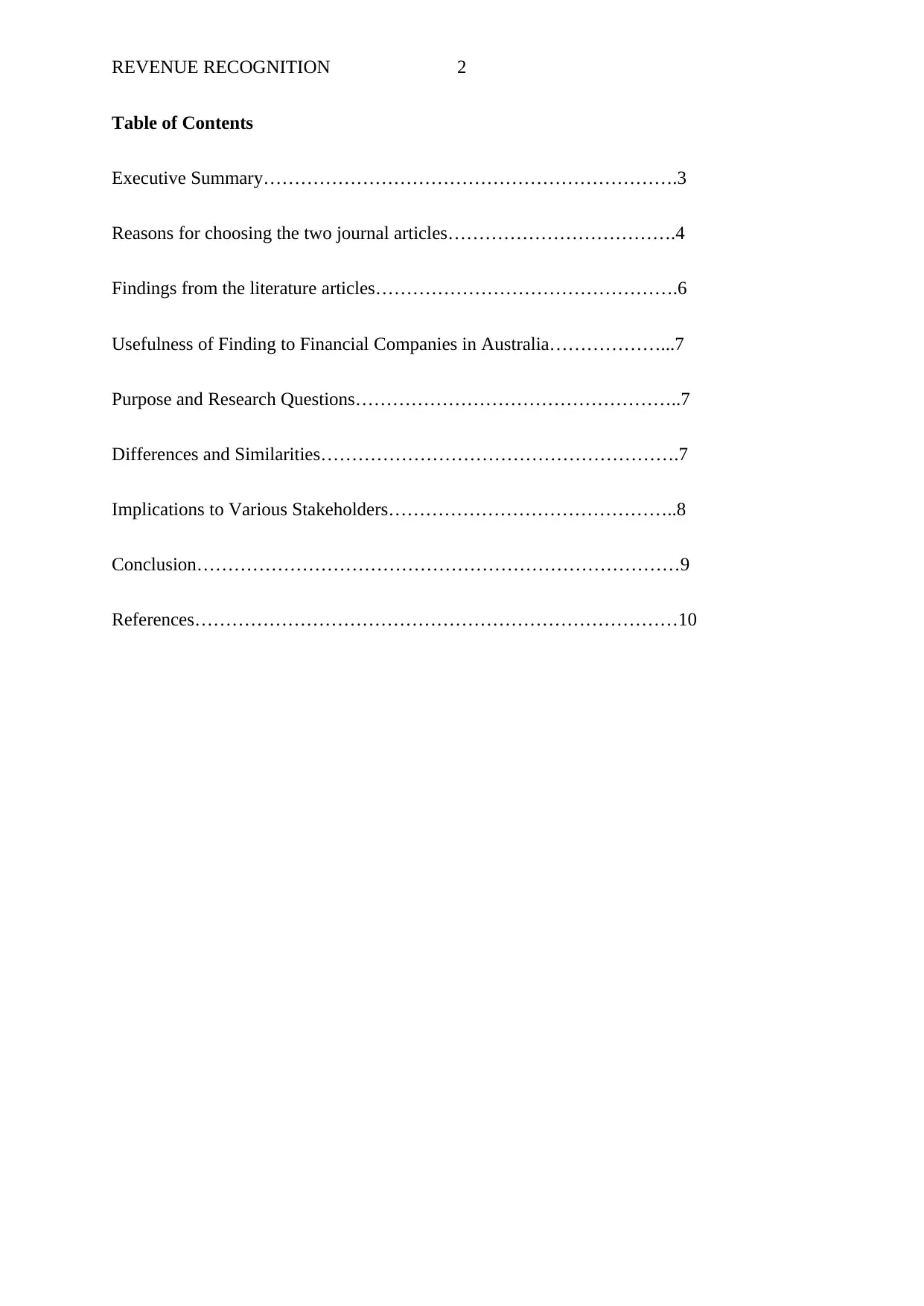
REVENUE RECOGNITION 2
Table of Contents
Executive Summary………………………………………………………….3
Reasons for choosing the two journal articles……………………………….4
Findings from the literature articles………………………………………….6
Usefulness of Finding to Financial Companies in Australia………………...7
Purpose and Research Questions……………………………………………..7
Differences and Similarities………………………………………………….7
Implications to Various Stakeholders………………………………………..8
Conclusion……………………………………………………………………9
References……………………………………………………………………10
Table of Contents
Executive Summary………………………………………………………….3
Reasons for choosing the two journal articles……………………………….4
Findings from the literature articles………………………………………….6
Usefulness of Finding to Financial Companies in Australia………………...7
Purpose and Research Questions……………………………………………..7
Differences and Similarities………………………………………………….7
Implications to Various Stakeholders………………………………………..8
Conclusion……………………………………………………………………9
References……………………………………………………………………10
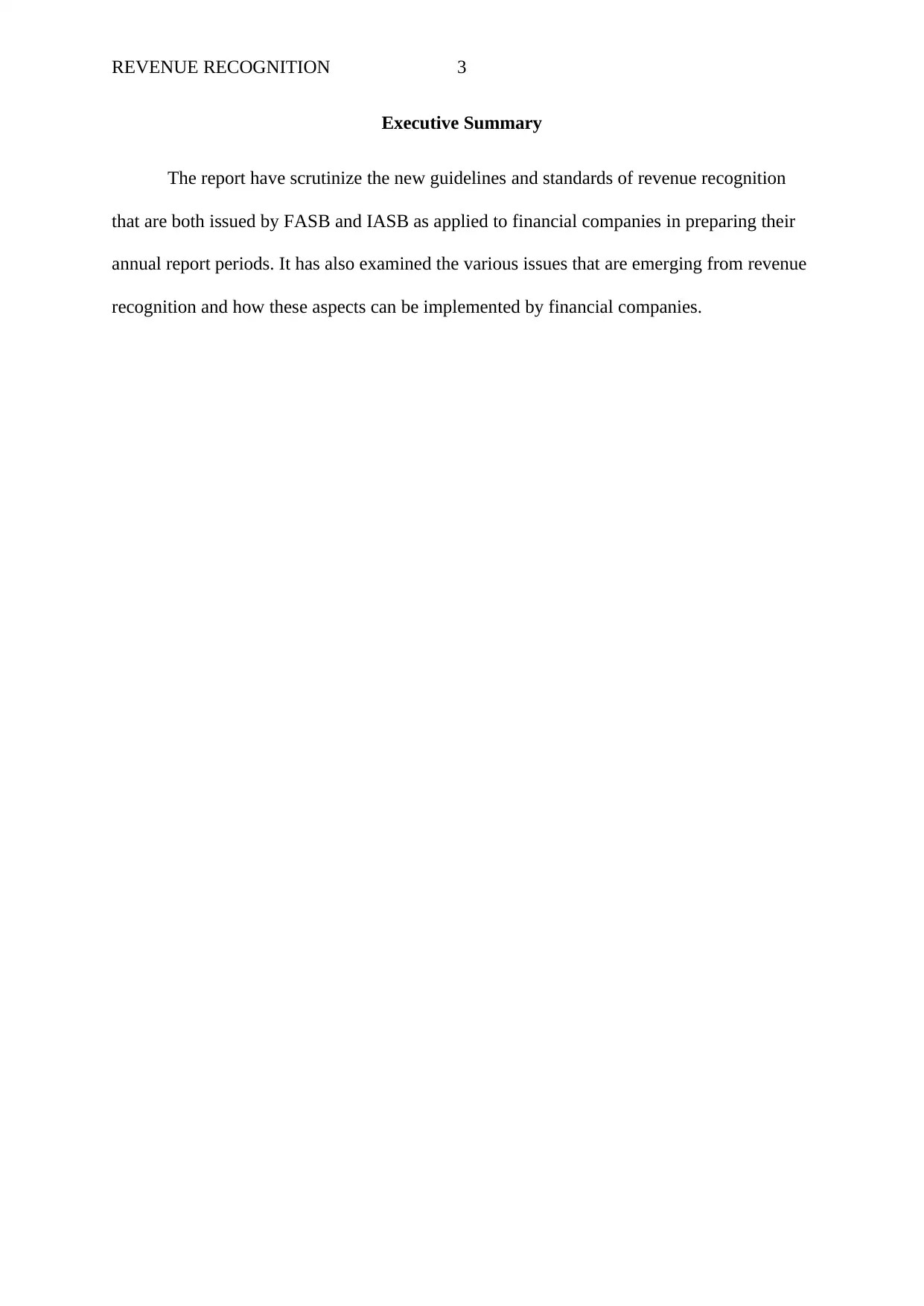
REVENUE RECOGNITION 3
Executive Summary
The report have scrutinize the new guidelines and standards of revenue recognition
that are both issued by FASB and IASB as applied to financial companies in preparing their
annual report periods. It has also examined the various issues that are emerging from revenue
recognition and how these aspects can be implemented by financial companies.
Executive Summary
The report have scrutinize the new guidelines and standards of revenue recognition
that are both issued by FASB and IASB as applied to financial companies in preparing their
annual report periods. It has also examined the various issues that are emerging from revenue
recognition and how these aspects can be implemented by financial companies.
⊘ This is a preview!⊘
Do you want full access?
Subscribe today to unlock all pages.

Trusted by 1+ million students worldwide
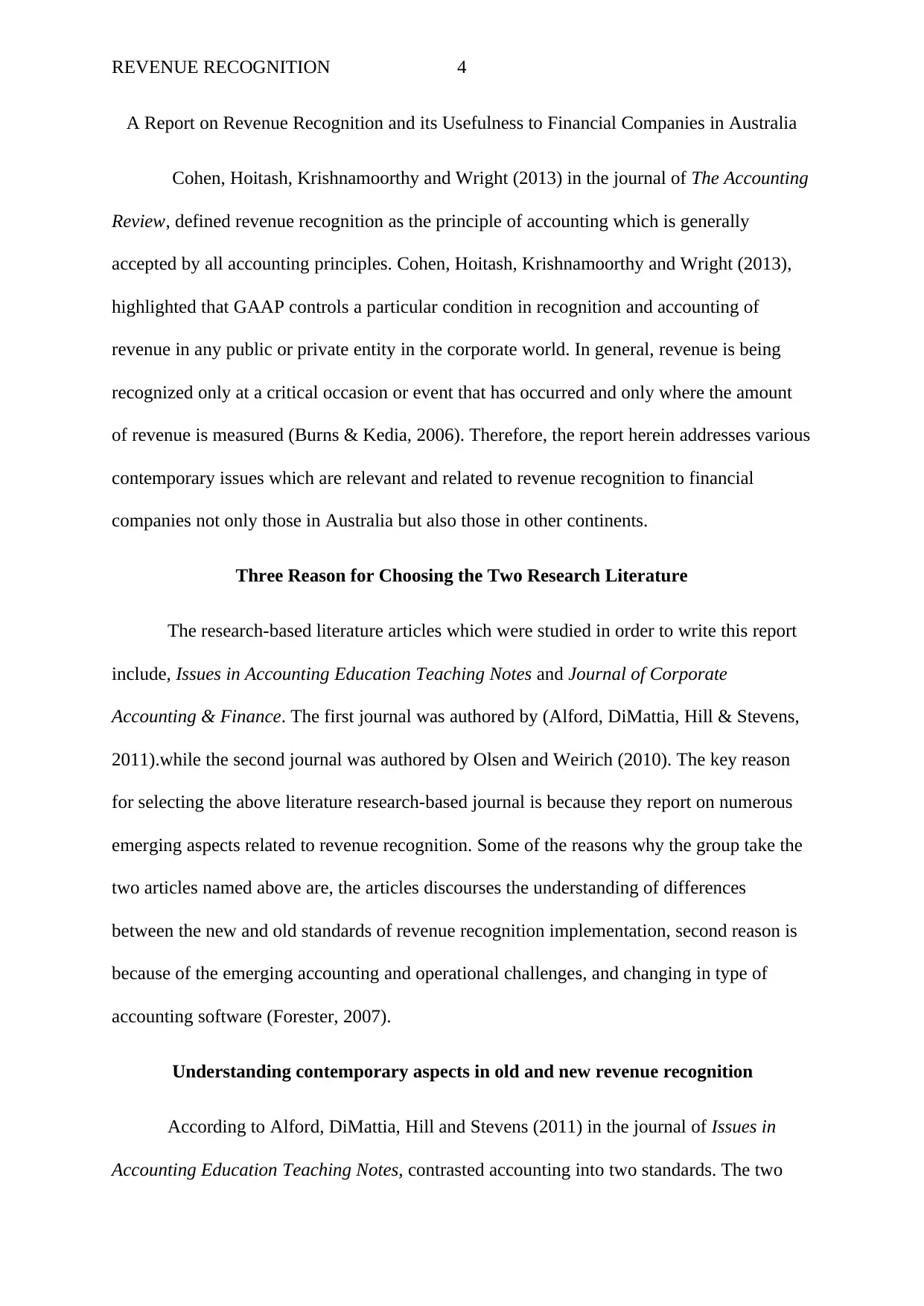
REVENUE RECOGNITION 4
A Report on Revenue Recognition and its Usefulness to Financial Companies in Australia
Cohen, Hoitash, Krishnamoorthy and Wright (2013) in the journal of The Accounting
Review, defined revenue recognition as the principle of accounting which is generally
accepted by all accounting principles. Cohen, Hoitash, Krishnamoorthy and Wright (2013),
highlighted that GAAP controls a particular condition in recognition and accounting of
revenue in any public or private entity in the corporate world. In general, revenue is being
recognized only at a critical occasion or event that has occurred and only where the amount
of revenue is measured (Burns & Kedia, 2006). Therefore, the report herein addresses various
contemporary issues which are relevant and related to revenue recognition to financial
companies not only those in Australia but also those in other continents.
Three Reason for Choosing the Two Research Literature
The research-based literature articles which were studied in order to write this report
include, Issues in Accounting Education Teaching Notes and Journal of Corporate
Accounting & Finance. The first journal was authored by (Alford, DiMattia, Hill & Stevens,
2011).while the second journal was authored by Olsen and Weirich (2010). The key reason
for selecting the above literature research-based journal is because they report on numerous
emerging aspects related to revenue recognition. Some of the reasons why the group take the
two articles named above are, the articles discourses the understanding of differences
between the new and old standards of revenue recognition implementation, second reason is
because of the emerging accounting and operational challenges, and changing in type of
accounting software (Forester, 2007).
Understanding contemporary aspects in old and new revenue recognition
According to Alford, DiMattia, Hill and Stevens (2011) in the journal of Issues in
Accounting Education Teaching Notes, contrasted accounting into two standards. The two
A Report on Revenue Recognition and its Usefulness to Financial Companies in Australia
Cohen, Hoitash, Krishnamoorthy and Wright (2013) in the journal of The Accounting
Review, defined revenue recognition as the principle of accounting which is generally
accepted by all accounting principles. Cohen, Hoitash, Krishnamoorthy and Wright (2013),
highlighted that GAAP controls a particular condition in recognition and accounting of
revenue in any public or private entity in the corporate world. In general, revenue is being
recognized only at a critical occasion or event that has occurred and only where the amount
of revenue is measured (Burns & Kedia, 2006). Therefore, the report herein addresses various
contemporary issues which are relevant and related to revenue recognition to financial
companies not only those in Australia but also those in other continents.
Three Reason for Choosing the Two Research Literature
The research-based literature articles which were studied in order to write this report
include, Issues in Accounting Education Teaching Notes and Journal of Corporate
Accounting & Finance. The first journal was authored by (Alford, DiMattia, Hill & Stevens,
2011).while the second journal was authored by Olsen and Weirich (2010). The key reason
for selecting the above literature research-based journal is because they report on numerous
emerging aspects related to revenue recognition. Some of the reasons why the group take the
two articles named above are, the articles discourses the understanding of differences
between the new and old standards of revenue recognition implementation, second reason is
because of the emerging accounting and operational challenges, and changing in type of
accounting software (Forester, 2007).
Understanding contemporary aspects in old and new revenue recognition
According to Alford, DiMattia, Hill and Stevens (2011) in the journal of Issues in
Accounting Education Teaching Notes, contrasted accounting into two standards. The two
Paraphrase This Document
Need a fresh take? Get an instant paraphrase of this document with our AI Paraphraser
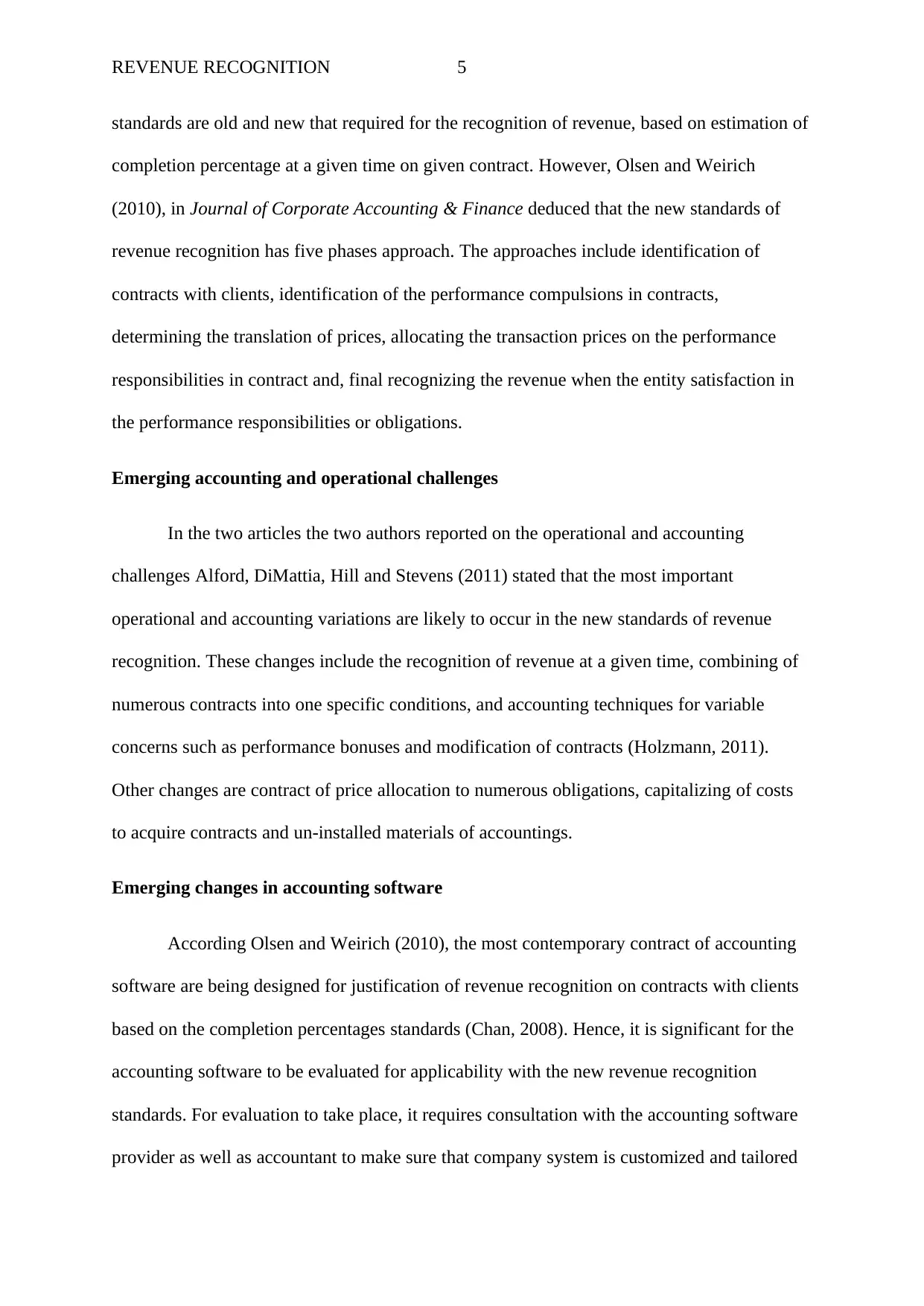
REVENUE RECOGNITION 5
standards are old and new that required for the recognition of revenue, based on estimation of
completion percentage at a given time on given contract. However, Olsen and Weirich
(2010), in Journal of Corporate Accounting & Finance deduced that the new standards of
revenue recognition has five phases approach. The approaches include identification of
contracts with clients, identification of the performance compulsions in contracts,
determining the translation of prices, allocating the transaction prices on the performance
responsibilities in contract and, final recognizing the revenue when the entity satisfaction in
the performance responsibilities or obligations.
Emerging accounting and operational challenges
In the two articles the two authors reported on the operational and accounting
challenges Alford, DiMattia, Hill and Stevens (2011) stated that the most important
operational and accounting variations are likely to occur in the new standards of revenue
recognition. These changes include the recognition of revenue at a given time, combining of
numerous contracts into one specific conditions, and accounting techniques for variable
concerns such as performance bonuses and modification of contracts (Holzmann, 2011).
Other changes are contract of price allocation to numerous obligations, capitalizing of costs
to acquire contracts and un-installed materials of accountings.
Emerging changes in accounting software
According Olsen and Weirich (2010), the most contemporary contract of accounting
software are being designed for justification of revenue recognition on contracts with clients
based on the completion percentages standards (Chan, 2008). Hence, it is significant for the
accounting software to be evaluated for applicability with the new revenue recognition
standards. For evaluation to take place, it requires consultation with the accounting software
provider as well as accountant to make sure that company system is customized and tailored
standards are old and new that required for the recognition of revenue, based on estimation of
completion percentage at a given time on given contract. However, Olsen and Weirich
(2010), in Journal of Corporate Accounting & Finance deduced that the new standards of
revenue recognition has five phases approach. The approaches include identification of
contracts with clients, identification of the performance compulsions in contracts,
determining the translation of prices, allocating the transaction prices on the performance
responsibilities in contract and, final recognizing the revenue when the entity satisfaction in
the performance responsibilities or obligations.
Emerging accounting and operational challenges
In the two articles the two authors reported on the operational and accounting
challenges Alford, DiMattia, Hill and Stevens (2011) stated that the most important
operational and accounting variations are likely to occur in the new standards of revenue
recognition. These changes include the recognition of revenue at a given time, combining of
numerous contracts into one specific conditions, and accounting techniques for variable
concerns such as performance bonuses and modification of contracts (Holzmann, 2011).
Other changes are contract of price allocation to numerous obligations, capitalizing of costs
to acquire contracts and un-installed materials of accountings.
Emerging changes in accounting software
According Olsen and Weirich (2010), the most contemporary contract of accounting
software are being designed for justification of revenue recognition on contracts with clients
based on the completion percentages standards (Chan, 2008). Hence, it is significant for the
accounting software to be evaluated for applicability with the new revenue recognition
standards. For evaluation to take place, it requires consultation with the accounting software
provider as well as accountant to make sure that company system is customized and tailored
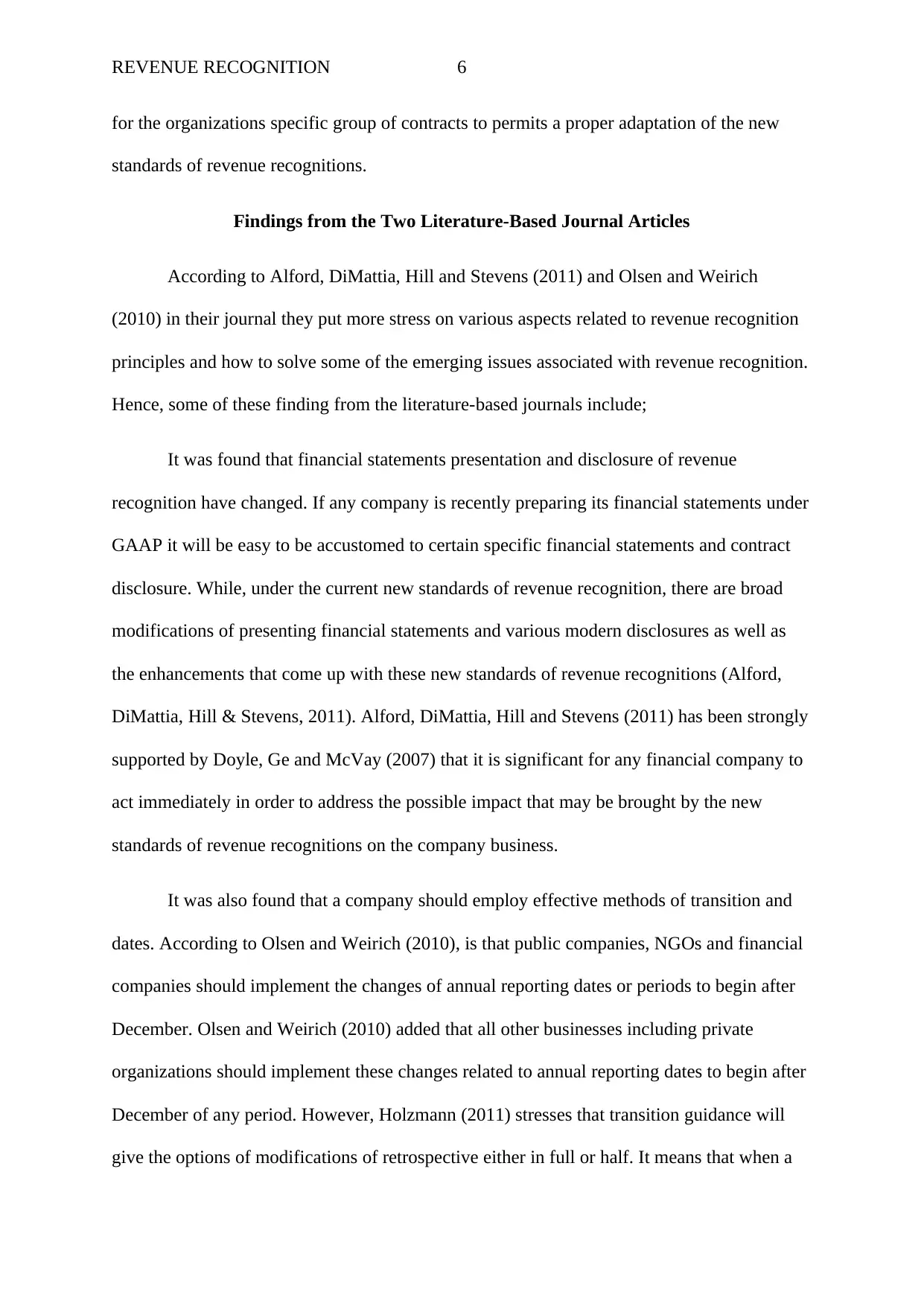
REVENUE RECOGNITION 6
for the organizations specific group of contracts to permits a proper adaptation of the new
standards of revenue recognitions.
Findings from the Two Literature-Based Journal Articles
According to Alford, DiMattia, Hill and Stevens (2011) and Olsen and Weirich
(2010) in their journal they put more stress on various aspects related to revenue recognition
principles and how to solve some of the emerging issues associated with revenue recognition.
Hence, some of these finding from the literature-based journals include;
It was found that financial statements presentation and disclosure of revenue
recognition have changed. If any company is recently preparing its financial statements under
GAAP it will be easy to be accustomed to certain specific financial statements and contract
disclosure. While, under the current new standards of revenue recognition, there are broad
modifications of presenting financial statements and various modern disclosures as well as
the enhancements that come up with these new standards of revenue recognitions (Alford,
DiMattia, Hill & Stevens, 2011). Alford, DiMattia, Hill and Stevens (2011) has been strongly
supported by Doyle, Ge and McVay (2007) that it is significant for any financial company to
act immediately in order to address the possible impact that may be brought by the new
standards of revenue recognitions on the company business.
It was also found that a company should employ effective methods of transition and
dates. According to Olsen and Weirich (2010), is that public companies, NGOs and financial
companies should implement the changes of annual reporting dates or periods to begin after
December. Olsen and Weirich (2010) added that all other businesses including private
organizations should implement these changes related to annual reporting dates to begin after
December of any period. However, Holzmann (2011) stresses that transition guidance will
give the options of modifications of retrospective either in full or half. It means that when a
for the organizations specific group of contracts to permits a proper adaptation of the new
standards of revenue recognitions.
Findings from the Two Literature-Based Journal Articles
According to Alford, DiMattia, Hill and Stevens (2011) and Olsen and Weirich
(2010) in their journal they put more stress on various aspects related to revenue recognition
principles and how to solve some of the emerging issues associated with revenue recognition.
Hence, some of these finding from the literature-based journals include;
It was found that financial statements presentation and disclosure of revenue
recognition have changed. If any company is recently preparing its financial statements under
GAAP it will be easy to be accustomed to certain specific financial statements and contract
disclosure. While, under the current new standards of revenue recognition, there are broad
modifications of presenting financial statements and various modern disclosures as well as
the enhancements that come up with these new standards of revenue recognitions (Alford,
DiMattia, Hill & Stevens, 2011). Alford, DiMattia, Hill and Stevens (2011) has been strongly
supported by Doyle, Ge and McVay (2007) that it is significant for any financial company to
act immediately in order to address the possible impact that may be brought by the new
standards of revenue recognitions on the company business.
It was also found that a company should employ effective methods of transition and
dates. According to Olsen and Weirich (2010), is that public companies, NGOs and financial
companies should implement the changes of annual reporting dates or periods to begin after
December. Olsen and Weirich (2010) added that all other businesses including private
organizations should implement these changes related to annual reporting dates to begin after
December of any period. However, Holzmann (2011) stresses that transition guidance will
give the options of modifications of retrospective either in full or half. It means that when a
⊘ This is a preview!⊘
Do you want full access?
Subscribe today to unlock all pages.

Trusted by 1+ million students worldwide
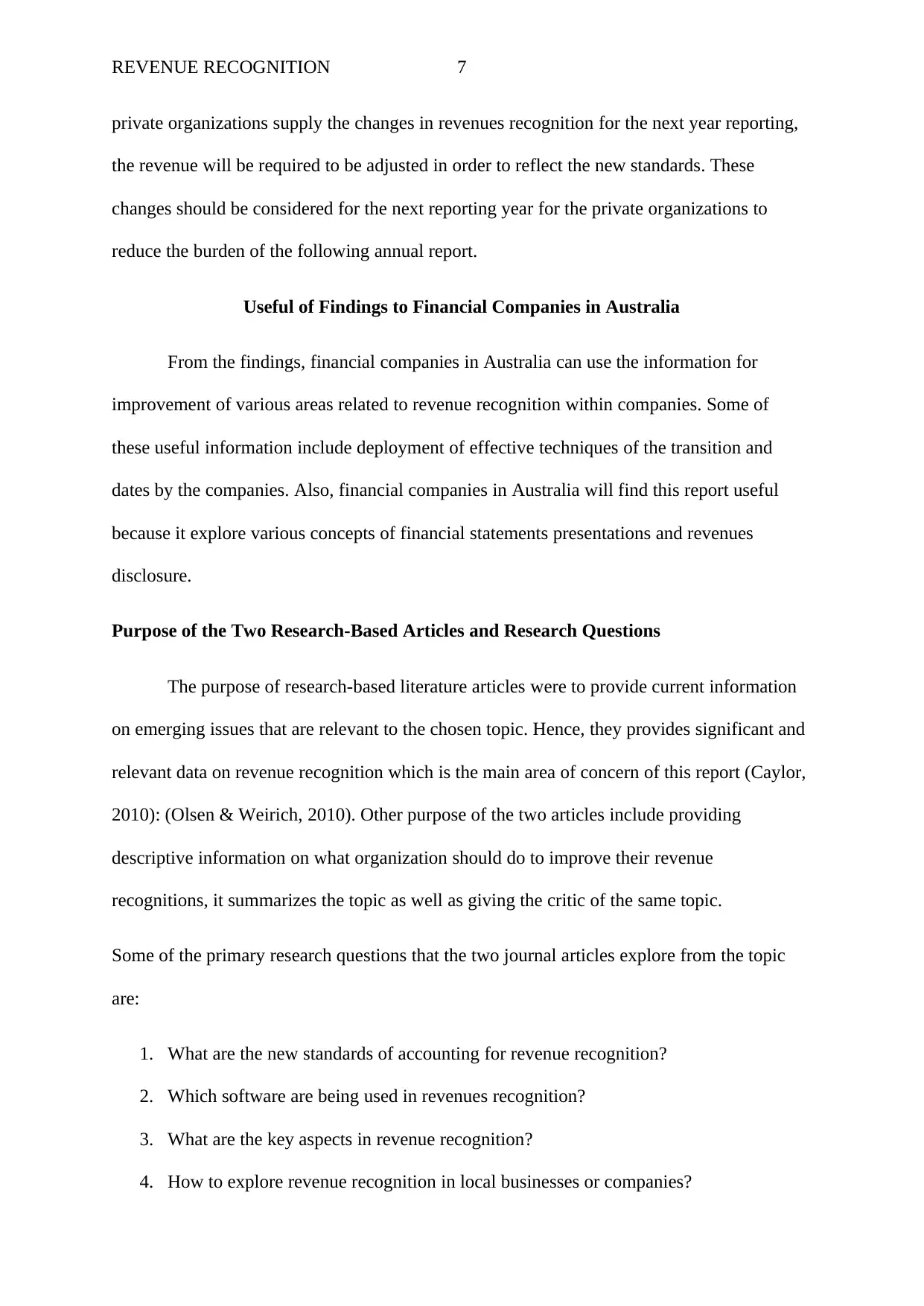
REVENUE RECOGNITION 7
private organizations supply the changes in revenues recognition for the next year reporting,
the revenue will be required to be adjusted in order to reflect the new standards. These
changes should be considered for the next reporting year for the private organizations to
reduce the burden of the following annual report.
Useful of Findings to Financial Companies in Australia
From the findings, financial companies in Australia can use the information for
improvement of various areas related to revenue recognition within companies. Some of
these useful information include deployment of effective techniques of the transition and
dates by the companies. Also, financial companies in Australia will find this report useful
because it explore various concepts of financial statements presentations and revenues
disclosure.
Purpose of the Two Research-Based Articles and Research Questions
The purpose of research-based literature articles were to provide current information
on emerging issues that are relevant to the chosen topic. Hence, they provides significant and
relevant data on revenue recognition which is the main area of concern of this report (Caylor,
2010): (Olsen & Weirich, 2010). Other purpose of the two articles include providing
descriptive information on what organization should do to improve their revenue
recognitions, it summarizes the topic as well as giving the critic of the same topic.
Some of the primary research questions that the two journal articles explore from the topic
are:
1. What are the new standards of accounting for revenue recognition?
2. Which software are being used in revenues recognition?
3. What are the key aspects in revenue recognition?
4. How to explore revenue recognition in local businesses or companies?
private organizations supply the changes in revenues recognition for the next year reporting,
the revenue will be required to be adjusted in order to reflect the new standards. These
changes should be considered for the next reporting year for the private organizations to
reduce the burden of the following annual report.
Useful of Findings to Financial Companies in Australia
From the findings, financial companies in Australia can use the information for
improvement of various areas related to revenue recognition within companies. Some of
these useful information include deployment of effective techniques of the transition and
dates by the companies. Also, financial companies in Australia will find this report useful
because it explore various concepts of financial statements presentations and revenues
disclosure.
Purpose of the Two Research-Based Articles and Research Questions
The purpose of research-based literature articles were to provide current information
on emerging issues that are relevant to the chosen topic. Hence, they provides significant and
relevant data on revenue recognition which is the main area of concern of this report (Caylor,
2010): (Olsen & Weirich, 2010). Other purpose of the two articles include providing
descriptive information on what organization should do to improve their revenue
recognitions, it summarizes the topic as well as giving the critic of the same topic.
Some of the primary research questions that the two journal articles explore from the topic
are:
1. What are the new standards of accounting for revenue recognition?
2. Which software are being used in revenues recognition?
3. What are the key aspects in revenue recognition?
4. How to explore revenue recognition in local businesses or companies?
Paraphrase This Document
Need a fresh take? Get an instant paraphrase of this document with our AI Paraphraser
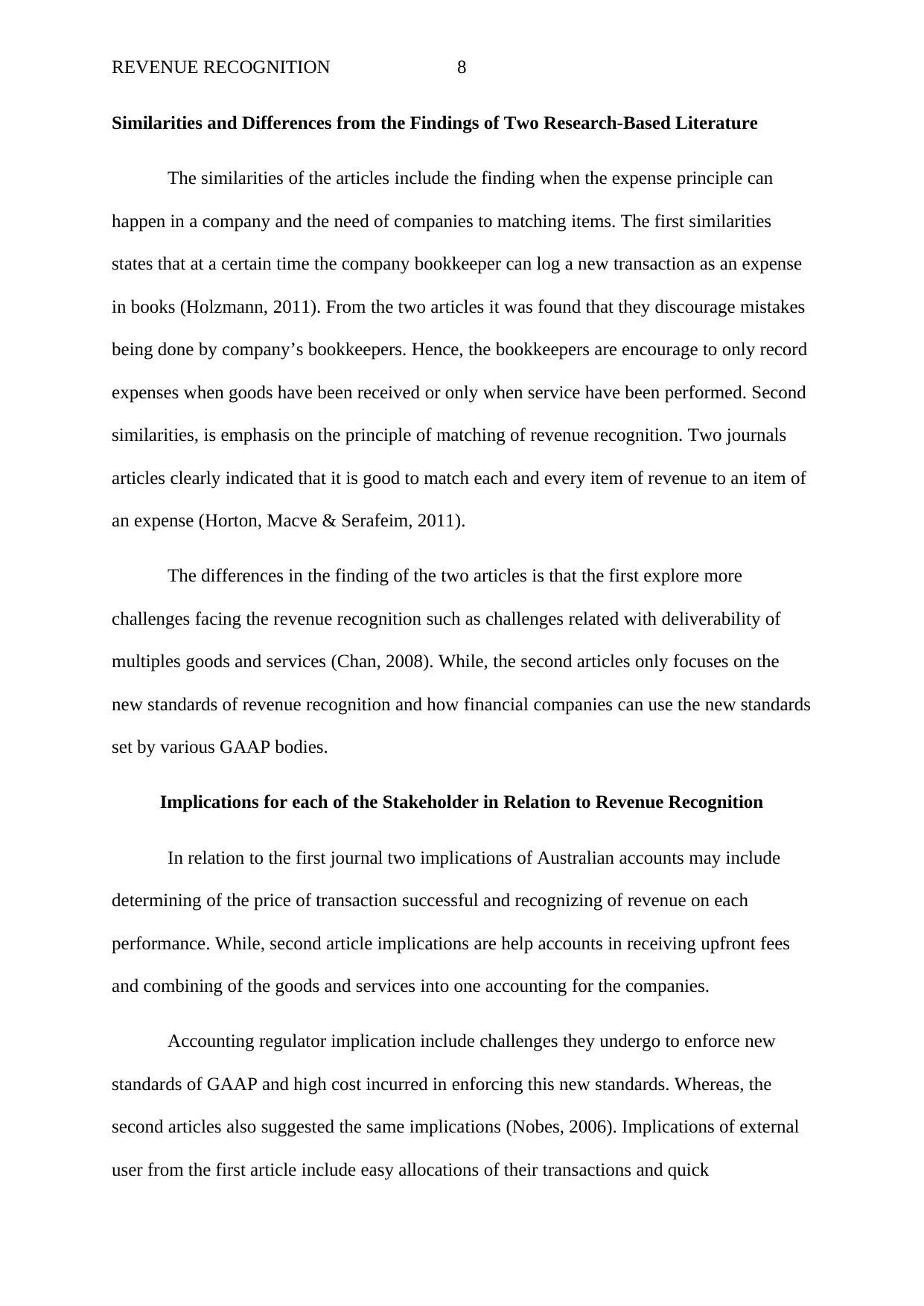
REVENUE RECOGNITION 8
Similarities and Differences from the Findings of Two Research-Based Literature
The similarities of the articles include the finding when the expense principle can
happen in a company and the need of companies to matching items. The first similarities
states that at a certain time the company bookkeeper can log a new transaction as an expense
in books (Holzmann, 2011). From the two articles it was found that they discourage mistakes
being done by company’s bookkeepers. Hence, the bookkeepers are encourage to only record
expenses when goods have been received or only when service have been performed. Second
similarities, is emphasis on the principle of matching of revenue recognition. Two journals
articles clearly indicated that it is good to match each and every item of revenue to an item of
an expense (Horton, Macve & Serafeim, 2011).
The differences in the finding of the two articles is that the first explore more
challenges facing the revenue recognition such as challenges related with deliverability of
multiples goods and services (Chan, 2008). While, the second articles only focuses on the
new standards of revenue recognition and how financial companies can use the new standards
set by various GAAP bodies.
Implications for each of the Stakeholder in Relation to Revenue Recognition
In relation to the first journal two implications of Australian accounts may include
determining of the price of transaction successful and recognizing of revenue on each
performance. While, second article implications are help accounts in receiving upfront fees
and combining of the goods and services into one accounting for the companies.
Accounting regulator implication include challenges they undergo to enforce new
standards of GAAP and high cost incurred in enforcing this new standards. Whereas, the
second articles also suggested the same implications (Nobes, 2006). Implications of external
user from the first article include easy allocations of their transactions and quick
Similarities and Differences from the Findings of Two Research-Based Literature
The similarities of the articles include the finding when the expense principle can
happen in a company and the need of companies to matching items. The first similarities
states that at a certain time the company bookkeeper can log a new transaction as an expense
in books (Holzmann, 2011). From the two articles it was found that they discourage mistakes
being done by company’s bookkeepers. Hence, the bookkeepers are encourage to only record
expenses when goods have been received or only when service have been performed. Second
similarities, is emphasis on the principle of matching of revenue recognition. Two journals
articles clearly indicated that it is good to match each and every item of revenue to an item of
an expense (Horton, Macve & Serafeim, 2011).
The differences in the finding of the two articles is that the first explore more
challenges facing the revenue recognition such as challenges related with deliverability of
multiples goods and services (Chan, 2008). While, the second articles only focuses on the
new standards of revenue recognition and how financial companies can use the new standards
set by various GAAP bodies.
Implications for each of the Stakeholder in Relation to Revenue Recognition
In relation to the first journal two implications of Australian accounts may include
determining of the price of transaction successful and recognizing of revenue on each
performance. While, second article implications are help accounts in receiving upfront fees
and combining of the goods and services into one accounting for the companies.
Accounting regulator implication include challenges they undergo to enforce new
standards of GAAP and high cost incurred in enforcing this new standards. Whereas, the
second articles also suggested the same implications (Nobes, 2006). Implications of external
user from the first article include easy allocations of their transactions and quick
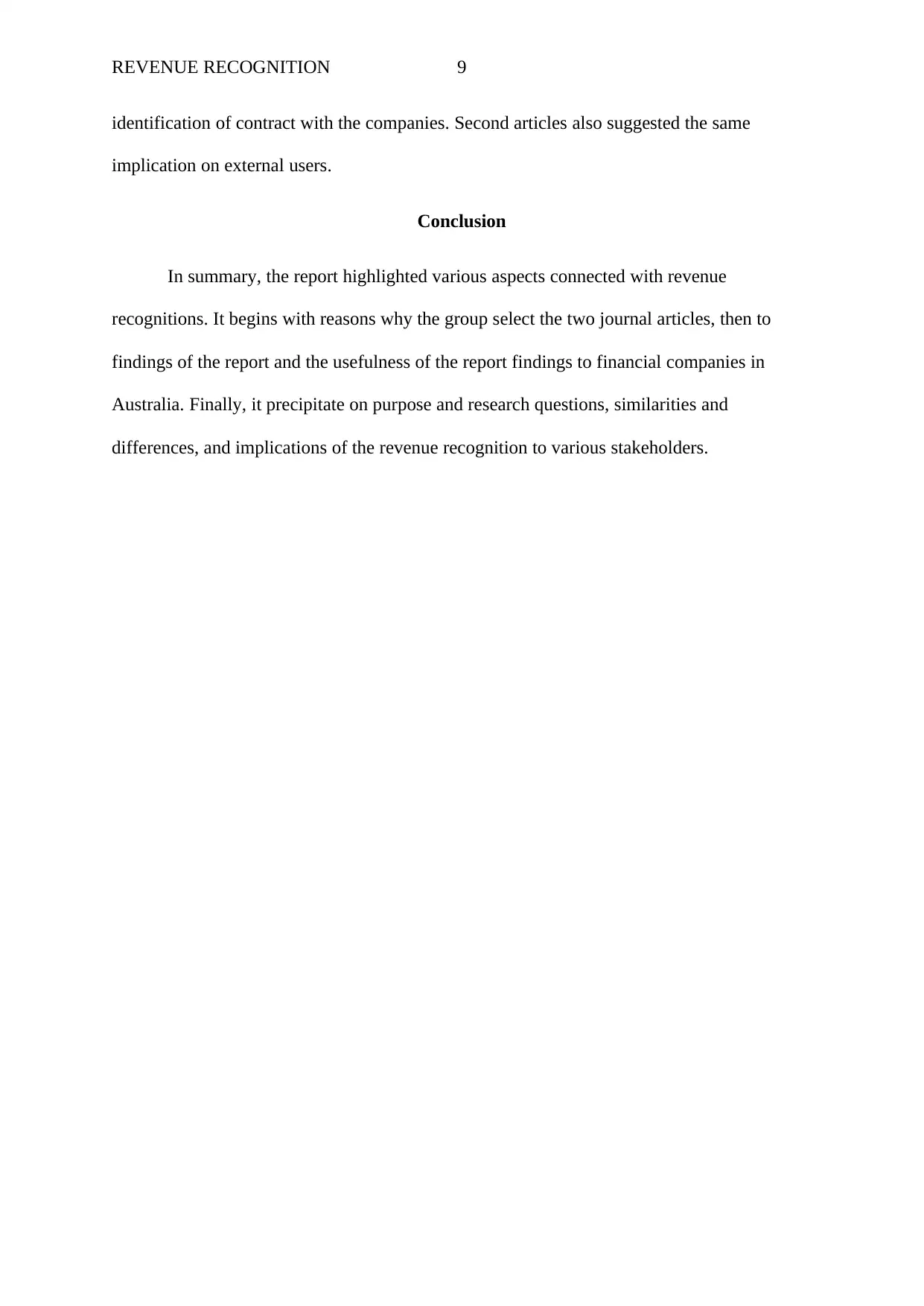
REVENUE RECOGNITION 9
identification of contract with the companies. Second articles also suggested the same
implication on external users.
Conclusion
In summary, the report highlighted various aspects connected with revenue
recognitions. It begins with reasons why the group select the two journal articles, then to
findings of the report and the usefulness of the report findings to financial companies in
Australia. Finally, it precipitate on purpose and research questions, similarities and
differences, and implications of the revenue recognition to various stakeholders.
identification of contract with the companies. Second articles also suggested the same
implication on external users.
Conclusion
In summary, the report highlighted various aspects connected with revenue
recognitions. It begins with reasons why the group select the two journal articles, then to
findings of the report and the usefulness of the report findings to financial companies in
Australia. Finally, it precipitate on purpose and research questions, similarities and
differences, and implications of the revenue recognition to various stakeholders.
⊘ This is a preview!⊘
Do you want full access?
Subscribe today to unlock all pages.

Trusted by 1+ million students worldwide
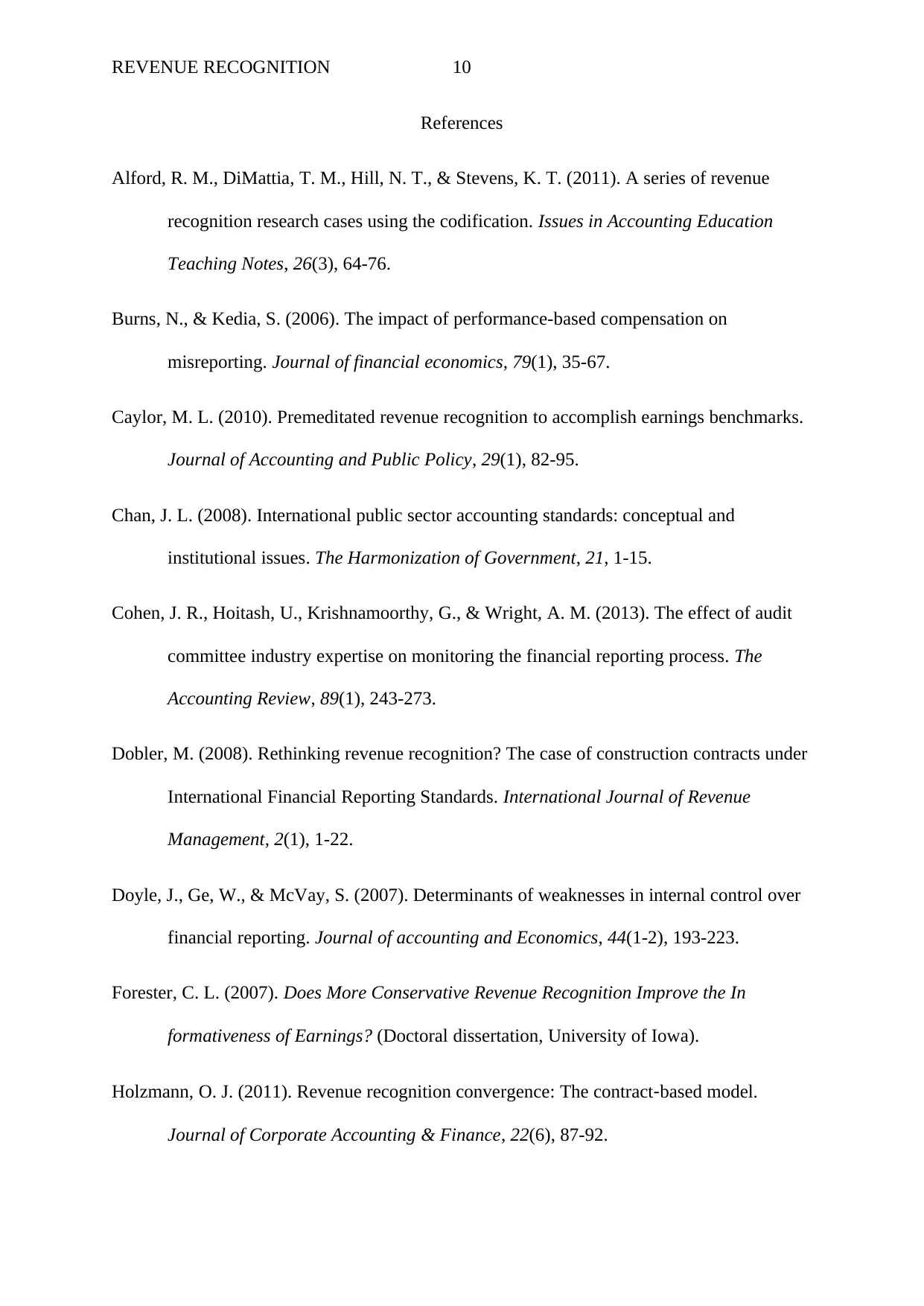
REVENUE RECOGNITION 10
References
Alford, R. M., DiMattia, T. M., Hill, N. T., & Stevens, K. T. (2011). A series of revenue
recognition research cases using the codification. Issues in Accounting Education
Teaching Notes, 26(3), 64-76.
Burns, N., & Kedia, S. (2006). The impact of performance-based compensation on
misreporting. Journal of financial economics, 79(1), 35-67.
Caylor, M. L. (2010). Premeditated revenue recognition to accomplish earnings benchmarks.
Journal of Accounting and Public Policy, 29(1), 82-95.
Chan, J. L. (2008). International public sector accounting standards: conceptual and
institutional issues. The Harmonization of Government, 21, 1-15.
Cohen, J. R., Hoitash, U., Krishnamoorthy, G., & Wright, A. M. (2013). The effect of audit
committee industry expertise on monitoring the financial reporting process. The
Accounting Review, 89(1), 243-273.
Dobler, M. (2008). Rethinking revenue recognition? The case of construction contracts under
International Financial Reporting Standards. International Journal of Revenue
Management, 2(1), 1-22.
Doyle, J., Ge, W., & McVay, S. (2007). Determinants of weaknesses in internal control over
financial reporting. Journal of accounting and Economics, 44(1-2), 193-223.
Forester, C. L. (2007). Does More Conservative Revenue Recognition Improve the In
formativeness of Earnings? (Doctoral dissertation, University of Iowa).
Holzmann, O. J. (2011). Revenue recognition convergence: The contract‐based model.
Journal of Corporate Accounting & Finance, 22(6), 87-92.
References
Alford, R. M., DiMattia, T. M., Hill, N. T., & Stevens, K. T. (2011). A series of revenue
recognition research cases using the codification. Issues in Accounting Education
Teaching Notes, 26(3), 64-76.
Burns, N., & Kedia, S. (2006). The impact of performance-based compensation on
misreporting. Journal of financial economics, 79(1), 35-67.
Caylor, M. L. (2010). Premeditated revenue recognition to accomplish earnings benchmarks.
Journal of Accounting and Public Policy, 29(1), 82-95.
Chan, J. L. (2008). International public sector accounting standards: conceptual and
institutional issues. The Harmonization of Government, 21, 1-15.
Cohen, J. R., Hoitash, U., Krishnamoorthy, G., & Wright, A. M. (2013). The effect of audit
committee industry expertise on monitoring the financial reporting process. The
Accounting Review, 89(1), 243-273.
Dobler, M. (2008). Rethinking revenue recognition? The case of construction contracts under
International Financial Reporting Standards. International Journal of Revenue
Management, 2(1), 1-22.
Doyle, J., Ge, W., & McVay, S. (2007). Determinants of weaknesses in internal control over
financial reporting. Journal of accounting and Economics, 44(1-2), 193-223.
Forester, C. L. (2007). Does More Conservative Revenue Recognition Improve the In
formativeness of Earnings? (Doctoral dissertation, University of Iowa).
Holzmann, O. J. (2011). Revenue recognition convergence: The contract‐based model.
Journal of Corporate Accounting & Finance, 22(6), 87-92.
Paraphrase This Document
Need a fresh take? Get an instant paraphrase of this document with our AI Paraphraser
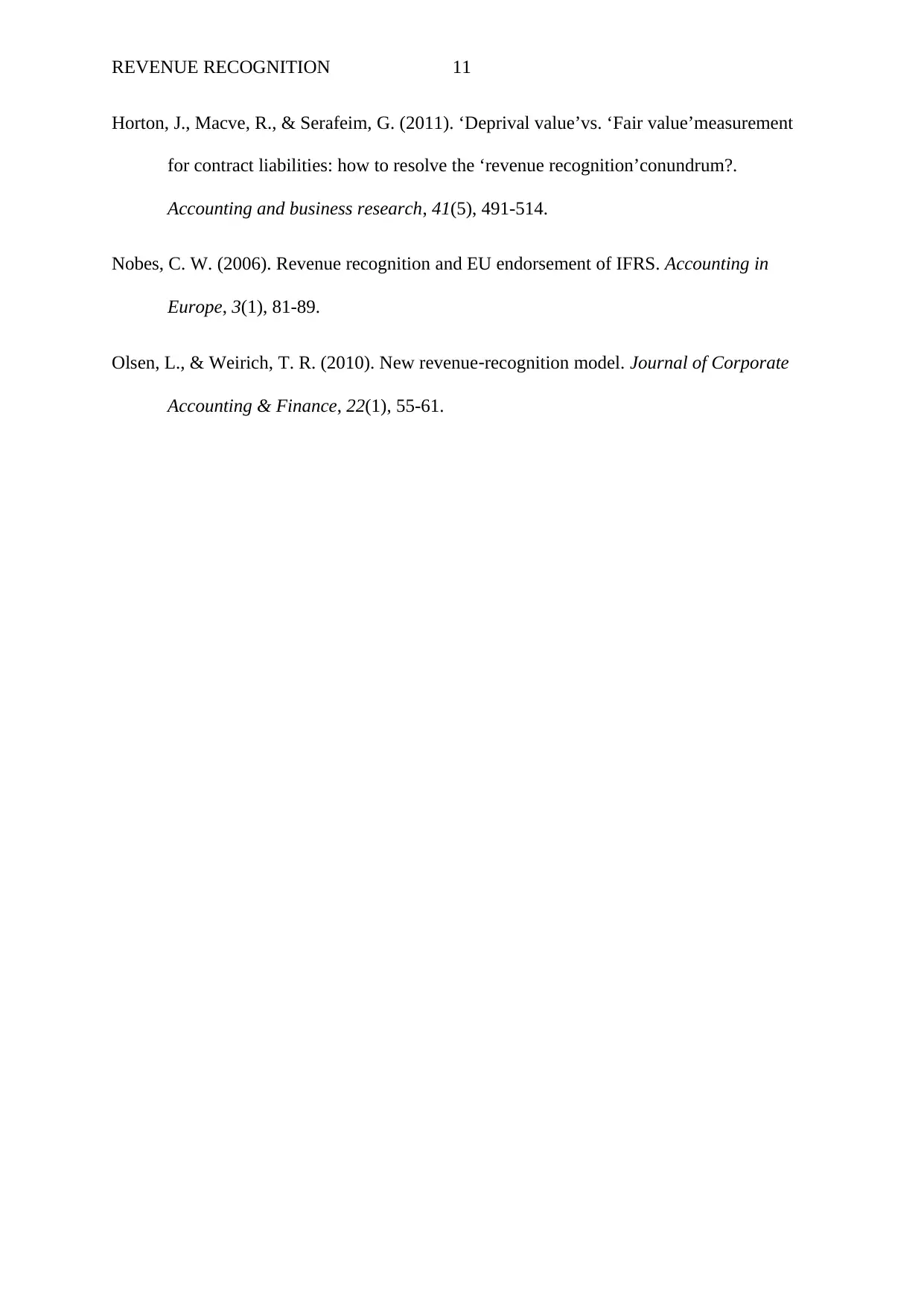
REVENUE RECOGNITION 11
Horton, J., Macve, R., & Serafeim, G. (2011). ‘Deprival value’vs. ‘Fair value’measurement
for contract liabilities: how to resolve the ‘revenue recognition’conundrum?.
Accounting and business research, 41(5), 491-514.
Nobes, C. W. (2006). Revenue recognition and EU endorsement of IFRS. Accounting in
Europe, 3(1), 81-89.
Olsen, L., & Weirich, T. R. (2010). New revenue‐recognition model. Journal of Corporate
Accounting & Finance, 22(1), 55-61.
Horton, J., Macve, R., & Serafeim, G. (2011). ‘Deprival value’vs. ‘Fair value’measurement
for contract liabilities: how to resolve the ‘revenue recognition’conundrum?.
Accounting and business research, 41(5), 491-514.
Nobes, C. W. (2006). Revenue recognition and EU endorsement of IFRS. Accounting in
Europe, 3(1), 81-89.
Olsen, L., & Weirich, T. R. (2010). New revenue‐recognition model. Journal of Corporate
Accounting & Finance, 22(1), 55-61.
1 out of 11
Your All-in-One AI-Powered Toolkit for Academic Success.
+13062052269
info@desklib.com
Available 24*7 on WhatsApp / Email
![[object Object]](/_next/static/media/star-bottom.7253800d.svg)
Unlock your academic potential
Copyright © 2020–2025 A2Z Services. All Rights Reserved. Developed and managed by ZUCOL.
